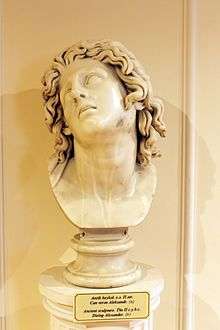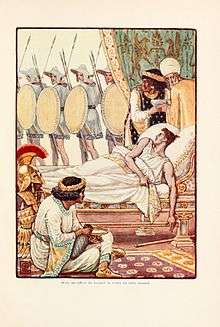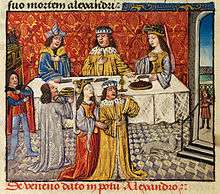Death of Alexander the Great

The death of Alexander the Great and subsequent related events have been the subjects of debates. According to a Babylonian astronomical diary, Alexander died between the evening of June 10 and the evening of June 11, 323 BC,[1] at the age of thirty-two. This happened in the palace of Nebuchadnezzar II in Babylon.
Macedonians and local residents wept at the news of the death, while Achaemenid subjects shaved their heads.[2] The mother of Darius III, Sisygambis, having learned of Alexander's death, refused sustenance and died a few days later.[3] Historians vary in their assessments of primary sources about Alexander's death, which results in different views.
Background
In February 323 BC, Alexander ordered his armies to prepare for the march to Babylon.[4] According to Arrian, after crossing the Tigris Alexander was met by Chaldeans, who advised him not to enter the city because their deity Bel had warned them that to do so at that time would be fatal for Alexander.[5] The Chaldeans also warned Alexander against marching westwards as he would then look to the setting sun, a symbol of decline.[5] It was suggested that he entered Babylon via the Royal Gate, in the western wall, where he would face to the east. Alexander followed this advice, but the route turned to be unfavorable because of swampy terrain.[5] According to Jona Lendering, "it seems that in May 323" the Babylonian astrologers tried to avert the misfortune by substituting Alexander with an ordinary person on the Babylonian throne, who would take the brunt of the omen.[4] The Greeks, however, did not understand that ritual.[4]
Prophecy of Calanus
Calanus was likely to be a Hindu Naga sadhu, whom Greeks called gymnosophists. He had accompanied the Greek army back from Punjab, upon request by Alexander. He was seventy-three years of age at that time. However, when Persian weather and travel fatigue weakened him, he informed Alexander that he would rather die than live disabled. He decided to take away his life by self-immolation. Although Alexander tried to desist him from doing so but upon the insistence of Calanus, Alexander relented and the job of building a pyre was entrusted to Ptolemy.[6] The place where this incident took place was Susa in the year 323 B.C.[7] Calanus is mentioned also by Alexander's admiral, Nearchus and Chares of Mytilene.[8] He did not flinch as he burnt to the astonishment of those who watched.[9][10] Before immolating himself alive on the pyre, his last words to Alexander were "We shall meet in Babylon".[11][12] Thus he is said to have prophesied the death of Alexander in Babylon. At the time of the death of Calanus, Alexander, however, did not have any plan to go to Babylon.[13][14] No one understood the meaning of his words "We shall meet in Babylon". It was only after Alexander fell sick and died in Babylon, that the Greeks came to realize what Calanus intended to convey.
Causes


Proposed causes of Alexander's death included alcoholic liver disease, fever, and strychnine poisoning, but little data support those versions.[15] According to the University of Maryland School of Medicine report of 1998, Alexander probably died of typhoid fever[16] (which, along with malaria, was common in ancient Babylon[17]). In the week before Alexander's death, historical accounts mention chills, sweats, exhaustion and high fever, typical symptoms of infectious diseases, including typhoid fever.[16] According to David W. Oldach from the University of Maryland Medical Center, Alexander also had "severe abdominal pain, causing him to cry out in agony".[16] The associated account, however, comes from the unreliable Alexander romance. According to Andrew N. Williams and Robert Arnott, in Alexander the Great's last days he became mute. He became mute because of a previous injury to his neck from the Siege of Cyropolis.[18]
Other popular theories hold that Alexander either died of malaria or was poisoned. Other retrodiagnoses include noninfectious diseases as well.[19] According to author Andrew Chugg, there is evidence Alexander died of malaria, having contracted it two weeks before his death while sailing in the marshes to inspect flood defences.[20] Chugg based his argument on Ephemerides by otherwise unknown Diodotus of Erythrae, although the authenticity of this source has been questioned.[20] It was also noted that the absence of the signature fever curve of Plasmodium falciparum (the expected parasite, given Alexander's travel history) diminishes the possibility of malaria.[19] The malaria version was nonetheless supported by Paul Cartledge.[20]
Throughout the centuries suspicions of possible poisoning have fallen on a number of alleged perpetrators, including one of Alexander's wives, his generals, his illegitimate half-brother or the royal cup-bearer.[20] The poisoning version is featured particularly in politically motivated Liber de Morte Testamentoque Alexandri (The Book On the Death and Testament of Alexander), which tries to discredit the family of Antipater. It was argued that the book was compiled in Polyperchon's circle, not before c. 317 BC.[21]
In Alexander the Great: The Death of a God, Paul C. Doherty claimed that Alexander was poisoned with arsenic by his possibly illegitimate half-brother Ptolemy I Soter.[20] However, this was disputed by New Zealand National Poisons Centre toxicologist Dr Leo Schep who discounted arsenic poisoning and instead suggested that he could have been poisoned by a wine made from the plant Veratrum album, known as white hellebore.[22] This plant was known to the Ancient Greeks and it can produce prolonged poisoning symptoms that match the course of events as described in the Alexander Romance. The article was published in the peer-reviewed medical journal Clinical Toxicology and suggested that if Alexander was poisoned, Veratrum album offers the most plausible cause.[22][23] This theory is backed by the writings of Ancient Greek historian, Diodorus, who had recorded Alexander becoming "stricken with pain after drinking a large bowl of wine."[24]
Epidemiologist John Marr and Charles Calisher put forward the West Nile fever as possible cause of Alexander's death. This version was deemed as "fairly compelling" by the University of Rhode Island epidemiologist Thomas Mather, who nonetheless noted that the West Nile virus tends to kill the elders or those with weakened immune systems.[25] The version of Marr and Calisher was also criticized by Burke A. Cunha from Winthrop University Hospital.[26] According to analysis of other authors in response to Marr and Calisher, the West Nile virus could not have infected humans before the 8th century AD.[26]
Other causes that have been put forward include acute pancreatitis provoked by "heavy alcohol consumption and a very rich meal",[27] acute endocarditis,[17] schistosomiasis brought on by Schistosoma haematobium,[17] and porphyria.[17] Fritz Schachermeyr proposed leukemia and malaria. When Alexander's symptoms were entered to the Global Infectious Disease Epidemiology Network, influenza gained the highest probability (41.2%) on the list of differential diagnoses.[19] However, according to Cunha, the symptoms and time course of Alexander's disease are inconsistent with influenza, as well as with malaria, schistosomiasis and poisoning in particular.[26]
Another theory moves away from disease and hypothesizes that Alexander's death was related to a congenital scoliotic syndrome.[28] It has been discussed that Alexander had structural neck deformities and oculomotor deficits,[29] and this could be associated with Klippel-Feil Syndrome, a rare congenital scoliotic disorder.[30] His physical deformities and symptoms leading up to his death are what lead experts to believe this. Some believe that as Alexander fell ill in his final days, he suffered from progressive epidural spinal cord compression, which left him quadriplegic.[31] However this hypothesis cannot be proven without a full analysis of Alexander's body.[30]
Body preservation

One ancient account reports that the planning and construction of an appropriate funerary cart to convey the body out from Babylon took two years from the time of Alexander's death.[32] It is not known exactly how the body was preserved for about two years before it was moved from Babylon. In 1889 E. A. Wallis Budge suggested that the body was submerged in a vat of honey,[33] while Plutarch reported treatment by Egyptian embalmers.[32]
Egyptian and Chaldean embalmers who arrived on June 16 are said to have attested to Alexander's lifelike appearance.[3] This was interpreted as a complication of typhoid fever, known as ascending paralysis, which causes a person to appear dead prior to death.[16]
Resting place
On its way back to Macedonia, the funerary cart with Alexander's body was met in Syria by one of Alexander's generals, the future ruler Ptolemy I Soter. In late 322 or early 321 BC Ptolemy diverted the body to Egypt where it was interred in Memphis, Egypt. In the late 4th or early 3rd century BC Alexander's body was transferred from the Memphis tomb to Alexandria for reburial[32] (by Ptolemy Philadelphus in c. 280 BC, according to Pausanias). Later Ptolemy Philopator placed Alexander's body in Alexandria's communal mausoleum.[32] Shortly after the death of Cleopatra, Alexander's resting place was visited by Augustus, who is said to have placed flowers on the tomb and a golden diadem upon Alexander's head.[32] By the 4th century AD the resting place of Alexander was no longer known; later authors, such as Ibn 'Abd al-Hakam, Al-Masudi and Leo the African, report having seen Alexander's tomb.[32] Leo the African in 1491 and George Sandys in 1611 reportedly saw the tomb in Alexandria.[34] According to one legend, the body lies in a crypt beneath an early Christian church.[35]
See also
Notes
- ↑ "A contemporary account of the death of Alexander". Livius.org. Retrieved Aug 21, 2011.
- ↑ Freeman, Philip (2011). Alexander the Great. Simon and Schuster. p. 320. ISBN 1-4165-9280-6.
- 1 2 Chugg, Andrew (2007). The Quest for the Tomb of Alexander the Great. Lulu.com. p. 25. ISBN 0-9556790-0-1.
- 1 2 3 Jona Lendering. "Death in Babylon". Livius.org. Retrieved Aug 22, 2011.
- 1 2 3 "Alexander and the Chaldaeans". Livius.org. Retrieved Aug 22, 2011.
- ↑ Alexander the Great. Robin Lane Fox. 1973. p. 416.
- ↑ Yādnāmah-ʾi Panjumīn Kungrih-ʾi Bayn al-Milalī-i Bāstānshināsī va Hunar-i Īrān. Ministry of Culture and Arts, Iran. Vizārat-i Farhang va Hunar. 1972. p. 224.
- ↑ The Sháhnáma of Firdausí By Arthur George Warner, Edmond Warner. 2001. p. 61.
- ↑ Defending the West: a critique of Edward Said's Orientalism Front Cover by Ibn Warraq. Prometheus Books. 2007. p. 108.
- ↑ The Cambridge History of Hellenistic Philosophy edited by Keimpe Algra. 1999. p. 243.
- ↑ History of Philosophy By Silvano Borruso. 2007. p. 50.
- ↑ My library My History Books on Google Play National Geographic, Volume 133. 1968. p. 64.
- ↑ National Geographic , Volume 133. 1968. p. 64.
- ↑ The philosophical books of Cicero. Duckworth. 1989. p. 186.
- ↑ Cunha BA (March 2004). "The death of Alexander the Great: malaria or typhoid fever". Infect. Dis. Clin. North Am. Infectious Disease Clinics of North America 2004 Mar;18(1):53-63. 18 (1): 53–63. doi:10.1016/S0891-5520(03)00090-4. PMID 15081504.
- 1 2 3 4 "INTESTINAL BUG LIKELY KILLED ALEXANDER THE GREAT". University of Maryland Medical Center. Retrieved Aug 21, 2011.
- 1 2 3 4 Carlos G. Musso. "MEGAS ALEXANDROS (Alexander The Great ): His Death Remains a Medical Mystery". Humane Medicine Health Care. Retrieved Aug 21, 2011.
- ↑ "A Stone at the Siege of Cyropolis and the Death of Alexander the Great".
- 1 2 3 John S. Marr; Charles H. Calisher. "Alexander the Great and West Nile Virus Encephalitis". CDC. Retrieved Aug 21, 2011.
- 1 2 3 4 5 "Disease, not conflict, ended the reign of Alexander the Great". The Independent on Sunday. Retrieved Aug 21, 2011.
- ↑ John Atkinson; Elsie Truter; Etienne Truter (Jan 1, 2009). "Alexander's last days: malaria and mind games?". Acta Classica. Retrieved Aug 21, 2011.
- 1 2 Schep LJ, Slaughter RJ, Vale JA, Wheatley P (January 2014). "Was the death of Alexander the Great due to poisoning? Was it Veratrum album?". Clinical Toxicology. 52 (1): 72–7. doi:10.3109/15563650.2013.870341. PMID 24369045.
- ↑ Bennett-Smith, Meredith (14 January 2014). "Was Alexander The Great Poisoned By Toxic Wine?". The Huffington Post. Retrieved 15 January 2014.
- ↑ Wolfe, Sarah (13 January 2014). "Alexander the Great was killed by toxic wine, says scientist". Public Radio International. Retrieved 5 March 2018.
- ↑ "Nature-Alexander the Great". GIDEON. Retrieved Aug 21, 2011.
- 1 2 3 "Alexander the Great and West Nile Virus Encephalitis". CDC. Retrieved Aug 21, 2011.
- ↑ Sbarounis CN (June 1997). "Did Alexander the Great die of acute pancreatitis?". J. Clin. Gastroenterol. Journal of Clinical Gastroenterology 1997 Jun;24(4):294-6. 24 (4): 294–6. doi:10.1097/00004836-199706000-00031. PMID 9252868.
- ↑ Hutan Ashrafian, "The Death of Alexander the Great - A Spinal Twist of Fate", Journal of the History of the Neurosciences, Vol. 13, 2004, pg. 138
- ↑ Hutan Ashrafian, "The Death of Alexander the Great - A Spinal Twist of Fate", Journal of the History of the Neurosciences, Vol. 13, 2004, pg.139
- 1 2 Hutan Ashrafian, "The Death of Alexander the Great - A Spinal Twist of Fate", Journal of the History of the Neurosciences, Vol. 13, 2004, pg. 140
- ↑ George K. York, David A. Steinberg, "Commentary. The Diseases of Alexander the Great", Journal of the History of the Neurosciences, Vol. 13, 2004, pg. 154
- 1 2 3 4 5 6 Robert S. Bianchi. "Hunting Alexander's Tomb". Archaeology.org. Retrieved Aug 21, 2011.
- ↑ Aufderheide, Arthur (2003). The scientific study of mummies. Cambridge University Press. pp. 261–262. ISBN 0-521-81826-5.
- ↑ Madden, Richard (1851). The Shrines and Sepulchres of the Old and New World. Newby. pp. 137–138.
- ↑ "Alexander's death riddle is 'solved'". BBC. June 11, 1998. Retrieved Aug 21, 2011.